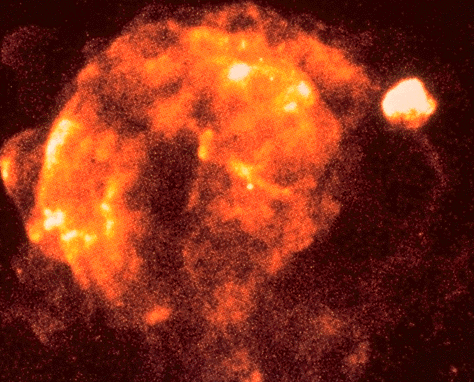
|
Explanation: What happens when a star explodes? A huge fireball of hot gas shoots out in all directions. When this gas slams into the existing interstellar medium, it heats up so much it glows in X-rays. The above picture by the ROSAT satellite has captured some of these X-rays and shown -- for the first time -- the Vela supernova explosion was roughly spherical. Non-uniformity of the interstellar medium causes Vela's appearance to be irregular. The size of this X-ray emitting spherical shell is immense - 230 light years across, covering over 100 times the sky-area of the full Moon. The supernova that created this nebula occurred about 1500 light years away and about 11,000 years ago. Coincidently, a completely different supernova shell can also be seen in X-rays in this picture! It is visible as the bright patch near the upper right. This Puppis supernova remnant nebula is actually about four times further than the Vela nebula.
|
January February March April May June July August September October November December |
| ||||||||||||||||||||||||||||||||||||||||||||||||
NASA Web Site Statements, Warnings, and Disclaimers
NASA Official: Jay Norris. Specific rights apply.
A service of: LHEA at NASA / GSFC
& Michigan Tech. U.
Based on Astronomy Picture
Of the Day
Publications with keywords: Vela - supernova remnant - supernova
Publications with words: Vela - supernova remnant - supernova
See also:
- Supernova Remnant Cassiopeia A
- APOD: 2025 January 8 Á Supernova Remnants Big and Small
- APOD: 2024 September 18 Á The Mermaid Nebula Supernova Remnant
- APOD: 2024 April 16 Á Filaments of the Vela Supernova Remnant
- APOD: 2024 April 3 Á Unusual Nebula Pa 30
- APOD: 2024 March 25 Á Sonified: The Jellyfish Nebula Supernova Remnant
- APOD: 2024 February 27 Á Supernova Remnant Simeis 147
